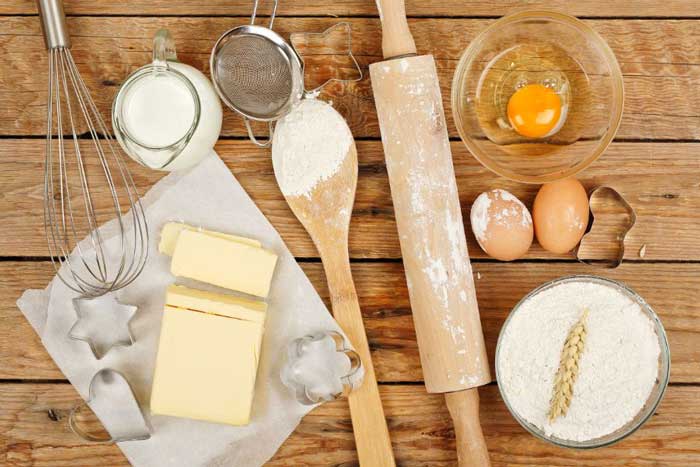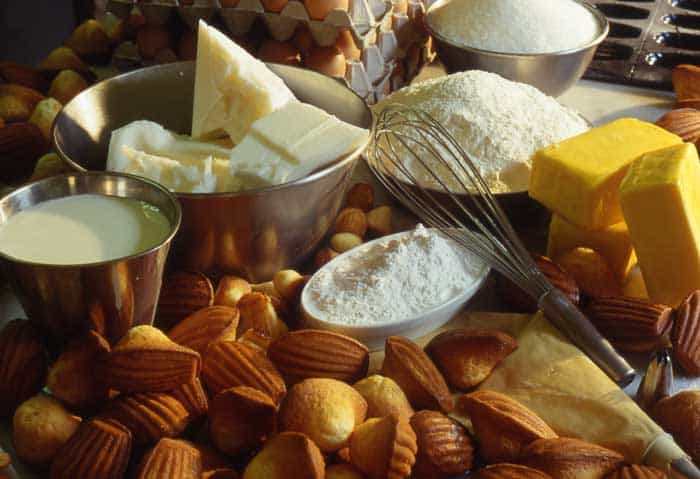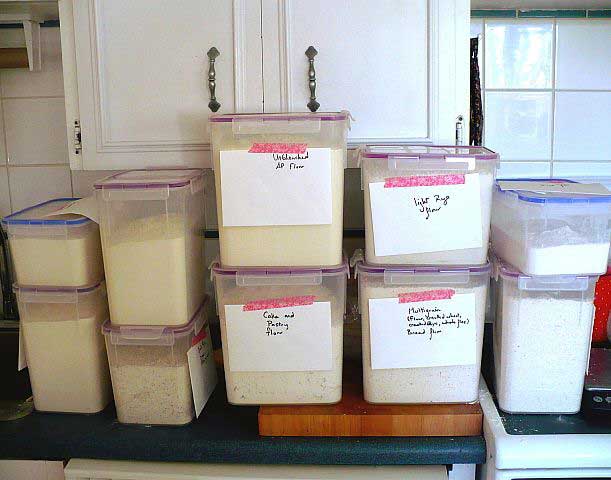Regardless of whether you’re a baker by profession or a hobbyist, all of us can relate to this one thing: it’s the fact that baking ingredients do not have a consistent shelf-life. So the best advice for any baker is to learn how to store baking ingredients properly. We’re here to discuss and teach you exactly that.
Let’s say you got yourself all your baking essentials for the perfect cake. Now, if you have opened the sealed packets once, then chances are that they might be spoiled by the next time you use them. This is an inevitable situation if you don’t know the methods of proper storage.
Don’t worry because we’re here to tell you everything you need to know to avoid this mess.
What Are the Basic Ingredients of Baking?
There’s a reason why baking ingredients are more or less the same across all continents. If you think about it, the way baking ingredients come together to form a cake is quite interesting.

So what are these baking ingredients that we are learning to protect? Well, there can never be one specific list, but we tried to round up a selection of essentials that are must-haves for baking. Remember that tools and equipment such as rolling pins and baking trays aren’t included in the essentials list.
- Flour
- Sugar and Salt
- Eggs
- Baking powder and Baking Soda
- Chocolate or Cocoa Powder
- Oils
- Nuts
- Yeast
- Sprinkles for decoration
How Should You Store Them?
The best way to understand whether you should refrigerate or store them at room temperature is by reading the label on their packaging. Usually, every ingredient comes with directions for optimum shelf life. Don’t worry if the instructions on the packet aren’t catering to your needs, because we got you covered.

Different ingredients require different methods of storing. Some need dry storage, whereas, for some, an air-tightened container is crucial. It mostly depends on their composition and source. Here are the best methods to store the aforementioned ingredients. These instructions are brief yet adequate for a good understanding.
Flour
- The first thing you need to keep in mind when storing flour is that it needs a dry place to be stored.
- Take out your flour from the package and keep it stored in an airtight container.
- Keep the flour away from coming in contact with air as much as possible. That way, you will be ensuring that it doesn’t turn clumpy.
- To ensure the maximum shelf-life, store it under 80 degrees Fahrenheit.
- Do a sniff test to check whether it’s fresh.
Sugar and Salt
- For granulated sugar and salt, go for zipper bags and then store that zipper bag inside an airtight container.
- Sugar can easily form clumps if you let air or moisture enter the container. So do not use wet spoons to take sugar from the container.
- Remember that you’re not supposed to refrigerate sugar.
- Don’t store your salt in metal containers.
- You can apply the same methods for storing brown sugar as well.
Eggs
- Store your eggs in the refrigerator to ensure longer periods of freshness.
- If you think that your eggs are likely to rot in a few days, then transfer them from the refrigerator door to the main body of the freeze.
- Don’t just rack up eggs one over another. Give them some space by using egg holders for storage.
- If you are using your eggs a long time after purchase, make sure that you check them before consumption.
- You may do the float test to gauge the freshness.
Baking Powder and Baking Soda
- If your baking powder and soda come in metal containers, then you do not need to transfer them to safer alternatives.
- Manufacturers produce the containers in such a way that it’s safe to store them in their original packaging. This method is only viable as long as you shut the lid tightly every time after using them.
- Avoid refrigerating baking powders. The condensation may cause unwanted reactions in the powder.
- Baking sodas are a sucker for other smells, so keep them away from spices.
- Lastly, avoid storing baking powder and baking soda in the same containers (sharing the same seal).
Chocolate and Cocoa Powder
- Chocolates with added sweetening are more likely to attract pests if you just leave them out in the open. So you need to store them properly if you want a good flavoring for your cakes.
- For chocolate bars, store them in refrigerators to make them last longer.
- But do not store cocoa powders in refrigerators as they can absorb the moisture to expire sooner.
- Go for airtight containers to avoid the formation of fungus on cocoa powder.
Oils
- All cooking oils should be stored in a cool area away from direct sunlight.
- You may store oils in your refrigerator if they are too delicate. These oils include sunflower oil and sesame oil.
- Usually, the oils that are commonly used for baking do not require refrigeration. So a kitchen cabinet will do fine as long as you close the cap of the bottle properly.
Nuts
- Nuts have the same odor-absorbing tendency as baking powders and sodas, so make sure to keep them away from fragrant spices.
- The crunchiness of nuts starts to disappear once it starts absorbing moisture from the air. Therefore an airtight container is a must.
- You will easily be able to store nuts at room temperature for about a month, so that’s a relief.
Yeast
- Bad yeast isn’t going to make you sick, but it can surely make your cake soggy and flat. So always refrigerate your yeast after purchase.
- By refrigerating fresh yeast, you can extend its shelf life up to a year.
- To check whether your yeast is still usable or not, just mix ½ teaspoon sugar, ½ cup warm water, and a pack of yeast. If it bubbles up substantially after 15 minutes, then it’s ready for baking.
Sprinkles and Other Condiments for Decoration
- Sprinkles are largely made out of condensed and dried sugar. So it’s normally a sweet item. And nothing screams of pest-trouble more than sweets! A simple solution is using airtight containers.
- Their original packaging is usually made airtight, so you won’t have to spend much in that department.
- Jimmies and other colored crystals last for more than 4 years past their ‘best by’ date. So sprinkles offer some room and flexibility as far as their shelf life is concerned.
Flavoring Essence
- Got essences for your cakes? Refrigerate them for best storage.
- Remember that refrigerating isn’t a necessity, but if you live in humid parts of the country, then it’s important.
Avoid ‘HML’ at All Costs
What does this HML stand for? Well, it stands for heat, moisture, and light. You can call this one of the golden rules of proper baking-ingredient storage. Simply keep your ingredient away from these three, and you’re good to go.

Now, if you’ve read through the entire guideline, then you’ve probably noticed that all ingredients follow this common rule. So if it gets hard for you to remember which ingredient should be stored in which way, you can quickly recall it using this technique.
Re-Organize Your Kitchen Today!
The final tip for proper storage is to keep all of your ingredients organized. This is a big deal because the more organized you are, the more accessible all the ingredients are to you. Accessible ingredients are always less likely to go bad due to constant transparency.
So now that you know how to store baking ingredients, it’s time for you to properly store and bump up the shelf life of all your favorite baking supplies!

